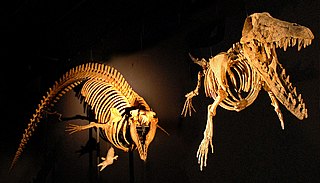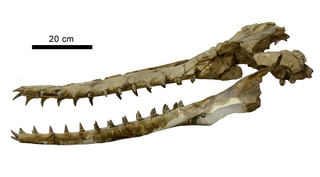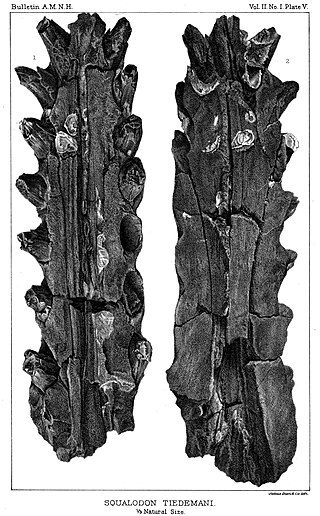
The pygmy killer whale is a poorly known and rarely seen oceanic dolphin. It is the only species in the genus Feresa. It derives its common name from sharing some physical characteristics with the orca, also known as the killer whale. It is the smallest cetacean species that has the word "whale" in its common name. Although the species has been known to be extremely aggressive in captivity, this aggressive behavior has not been observed in the wild.

Squalodon is an extinct genus of whales of the Oligocene and Miocene epochs, belonging to the family Squalodontidae. Named by Jean-Pierre Sylvestre de Grateloup in 1840, it was originally believed to be an iguanodontid dinosaur but has since been reclassified. The name Squalodon comes from Squalus, a genus of shark. As a result, its name means "shark tooth". Its closest modern relative is the South Asian river dolphin.

Archaeoceti, or Zeuglodontes in older literature, is a paraphyletic group of primitive cetaceans that lived from the Early Eocene to the late Oligocene. Representing the earliest cetacean radiation, they include the initial amphibious stages in cetacean evolution, thus are the ancestors of both modern cetacean suborders, Mysticeti and Odontoceti. This initial diversification occurred in the shallow waters that separated India and Asia 53 to 45 mya, resulting in some 30 species adapted to a fully oceanic life. Echolocation and filter-feeding evolved during a second radiation 36 to 35 mya.
Kentriodon is an extinct genus of toothed whale related to modern-day dolphins. Fossils have been found in North America, Europe and Japan. Several species have been described.

Aetiocetus is a genus of extinct basal mysticete, or baleen whale that lived 33.9 to 23.03 million years ago, in the Oligocene in the North Pacific ocean, around Japan, Mexico, and Oregon, U.S. It was first described by Douglas Emlong in 1966 and currently contains known four species, A. cotylalveus, A. polydentatus, A. tomitai, and A. weltoni. These whales are remarkable for their retention of teeth and presence of nutrient foramina, indicating that they possessed baleen. Thus, Aetiocetus represents the transition from teeth to baleen in Oligocene mysticetes. Baleen is a highly derived character, or synapomorphy, of mysticetes, and is a keratinous structure that grows from the palate, or roof of the mouth, of the whale. The presence of baleen is inferred from the fossil record in the skull of Aetiocetus. Aetiocetus is known from both sides of the Pacific Ocean: it was first documented in Oregon, United States, but it is also known from Japan and Mexico. The genus is currently constrained to the Northern hemisphere and has little value in biostratigraphic studies of the Oligocene due to its limited occurrences across the Pacific.

Xenorophidae is an extinct family of odontocetes, currently known from the Oligocene of the Southeastern United States. Known genera of xenorophids include Albertocetus, Archaeodelphis, Xenorophus, Cotylocara, Echovenator, and Inermorostrum.
The Ashley Formation is a geologic formation in South Carolina. It preserves fossils dating back to the Paleogene period.

Otekaikea is an extinct genus of toothed whale closely related to Waipatia. It is known from the late Oligocene (Chattian) of New Zealand.
Microcetus is a genus of extinct odontocete from the late Oligocene (Chattian) of Nordrhein-Westfalen, Germany.
Squaloziphius is an extinct genus of odontocete cetacean from the Early Miocene (Aquitanian) aged marine deposits in Washington state.

Agorophius is an extinct genus of toothed whale that lived during the Oligocene period, approximately 32 million years ago, in the waters off what is now South Carolina.

Mirocetus is a genus of archaic odontocete from the late Oligocene (Chattian) of Azerbaijan. Like many other primitive odontocetes, its classification has been fluid since its description.
Xenorophus is a genus of primitive odontocete from late Oligocene (Chattian) marine deposits in South Carolina. It belongs to the Xenorophidae.
Echovenator is a genus of primitive odontocete from late Oligocene (Chattian) marine deposits in South Carolina. It belongs to the Xenorophidae.

Albertocetus is an extinct genus of primitive odontocete cetacean from early Oligocene (Rupelian) marine deposits in North Carolina, and belonging to the family Xenorophidae.

Phoberodon is a genus of archaic odontocete cetacean from the Early Miocene (Burdigalian) of Patagonia, Argentina.

Kekenodon is an extinct kekenodontid early whale from the Late Oligocene (Chattian) of New Zealand. Measuring 8–9 m (26–30 ft) long, it was a large raptorial whale which hunted marine mammals and penguins. Although at times classified as a basilosaurid, mysticete, or odontocete, recent work suggests that it represents a phylogenetic intermediate form between Basilosauridae and Neoceti.
Inticetus is an extinct genus of Early Miocene odontocete from the Chilcatay Formation, Pisco Basin, Peru.

Ankylorhiza is an extinct genus of toothed whale that lived in what is now the United States during the Oligocene epoch, between 29 and 23.5 million years ago. The type and only known species is A. tiedemani, though two fossil skeletons may represent an additional, second species within the genus. Ankylorhiza was about 4.8 meters (16 ft) long, with a long, robust skull bearing conical teeth that were angled forwards at the tip of the snout.

Olympicetus is an extinct genus of small simocetid toothed whales that lived during the Oligocene epoch in what is now the coasts of Washington, about 33.7 million to 26.5 million years ago. The type species is Olympicetus avitus, known from the littoral Pysht Formation and described in 2017. A second species, Olympicetus thalassodon, was named in 2023 and it is also known from this formation.












